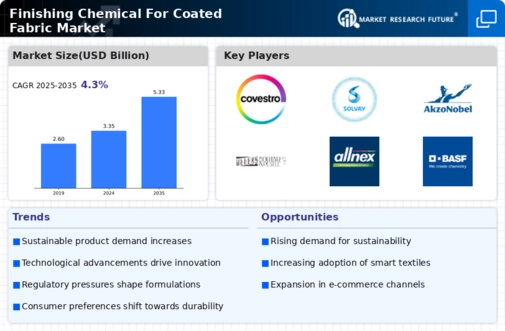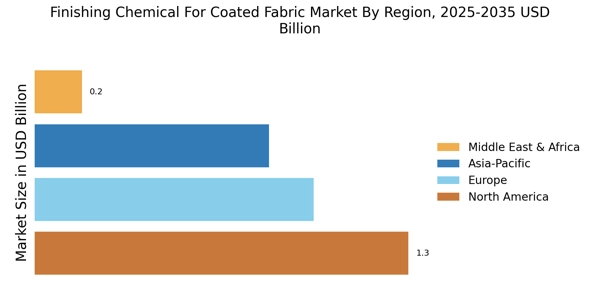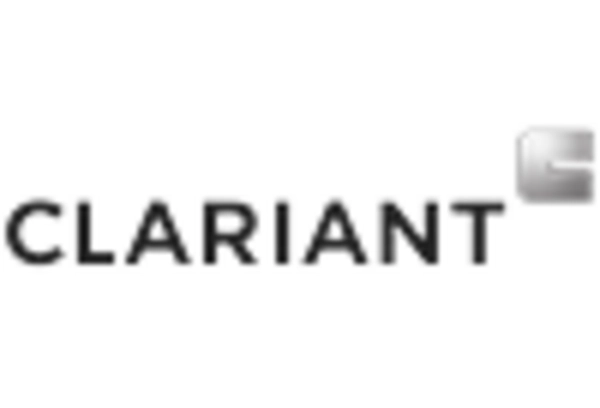Growth in the Textile Industry
The Finishing Chemical For Coated Fabric Market is closely linked to the overall growth of the textile industry. As consumer preferences shift towards high-performance fabrics, the demand for coated textiles is on the rise. This trend is particularly evident in the fashion and sportswear segments, where performance attributes such as breathability and moisture management are paramount. Recent market data indicates that the textile industry is projected to expand at a CAGR of around 4% in the coming years, which will likely bolster the demand for finishing chemicals. Manufacturers are increasingly investing in research and development to create specialized finishing chemicals that cater to the evolving needs of the textile market, thus enhancing the growth prospects of the finishing chemical sector.
Increased Focus on Aesthetic Appeal
The Finishing Chemical For Coated Fabric Market is witnessing an increased focus on aesthetic appeal in coated fabrics. As consumers become more discerning about the appearance and feel of textiles, manufacturers are investing in finishing chemicals that enhance the visual and tactile properties of fabrics. This trend is particularly prominent in the fashion and interior design sectors, where the aesthetic quality of coated fabrics can significantly influence purchasing decisions. Market Research Future suggest that the demand for visually appealing coated fabrics is expected to grow, driven by trends in home decor and fashion. Consequently, the finishing chemical market is likely to benefit from this emphasis on aesthetics, as manufacturers seek to develop innovative solutions that meet consumer expectations.
Innovations in Coating Technologies
Innovations in coating technologies are significantly influencing the Finishing Chemical For Coated Fabric Market. Advances in nanotechnology and polymer chemistry are leading to the development of new finishing chemicals that enhance the properties of coated fabrics. These innovations allow for improved water repellency, UV resistance, and antimicrobial properties, which are essential for various applications, including outdoor gear and medical textiles. Market analysis suggests that the introduction of smart textiles, which integrate electronic components with coated fabrics, is likely to create new opportunities for finishing chemicals. As manufacturers seek to differentiate their products, the demand for innovative finishing solutions is expected to rise, thereby driving growth in the finishing chemical market.
Rising Demand for Protective Fabrics
The Finishing Chemical For Coated Fabric Market is experiencing a notable increase in demand for protective fabrics across various sectors, including automotive, construction, and healthcare. This surge is primarily driven by the need for materials that offer enhanced durability, water resistance, and chemical protection. For instance, the automotive sector is increasingly utilizing coated fabrics for seat covers and interior linings, which require finishing chemicals to ensure longevity and performance. Market data indicates that the demand for protective fabrics is projected to grow at a compound annual growth rate (CAGR) of approximately 5% over the next five years, further propelling the finishing chemical market. As industries prioritize safety and performance, the role of finishing chemicals becomes increasingly critical in meeting these evolving requirements.
Regulatory Compliance and Safety Standards
Regulatory compliance and safety standards are becoming increasingly stringent, impacting the Finishing Chemical For Coated Fabric Market. Governments and regulatory bodies are implementing stricter guidelines regarding the use of chemicals in textile production, particularly concerning environmental sustainability and worker safety. This shift necessitates the development of eco-friendly finishing chemicals that comply with these regulations. As a result, manufacturers are compelled to innovate and reformulate their products to meet these new standards. Market trends indicate that the demand for sustainable and non-toxic finishing chemicals is likely to rise, as companies strive to align with regulatory requirements while also appealing to environmentally conscious consumers. This evolving landscape presents both challenges and opportunities for the finishing chemical market.


















Leave a Comment